Introduction
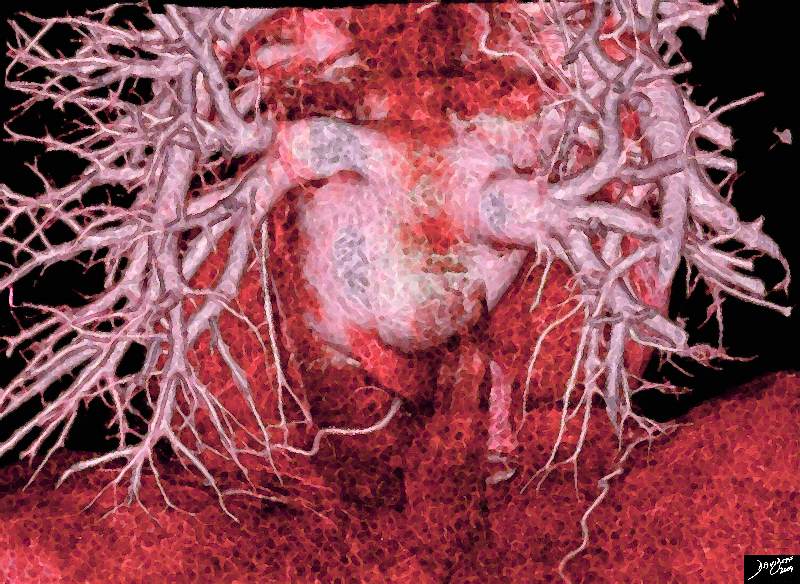
Normal 3D reconstruction of a CT scan of the Heart Showing the Left Atrium and Pulmonary Veins
Ashley Davidoff MD TheCommonVein.net
77612b.3kb07.8s

This normal anatomic specimen from a posterior aspect showing the LPA (1) and upper lobe pulmonary veins (2) and lower lobe pulmonary veins (3). The two veins to one artery is the usual. Venous inflow must of course equal arterial outflow and so each vein carries about half the load and are about half the size of the main branch pulmonary artery
Ashley Davidoff MD. TheCommonVein.net 06881labelled
The pulmonary veins drain the lungs of the blood supplied by the pulmonary artery, and the bronchial veins drain the blood from the areas supplied by the bronchial artery. Whereas the pulmonary veins contain oxygenated blood the bronchial veins contain deoxygenated blood. 98-99% of the blood in the lungs is in the pulmonary arterial –venous circulation while the remaining blood is in the bronchial circulation.
The bronchial veins have a deep and a superficial system. The deep bronchial veins drain either into the pulmonary veins or into the left atrium. The superficial bronchial veins drain the extra pulmonary bronchi, visceral pleura, and hilar lymph nodes and drain into the azygous system on the right side and the superior intercostal vein or the hemi-azygous system on the left.
Principles
Structure
Single common vein during embryology (4th week gestation) incorporated into the left dorsal atrium with 70% of patients having 4 pulmonary veins left superior (LS) left inferior (LI) right superior (RS) and right inferior (RI) which usually accommodates the middle lobe vein). The myocardium of the left atrium extends over the pulmonary vein for 1-2cms.
Congenital anomalies occur when there is over incorporation or under incorporation
Parts
Histology The Secondary Lobule
The veins run in the interlobular septa with the lymphatics and the interlobular septa

The secondary lobule is housed in a connective tissue framework in which run the lymphatic and venular tributaries . Together these 3 structures form the interlobular septum.
The lobar arteriole enters the framework, accompanied by the lobar bronchiole, and they all run together and form the interlobular septa. This structure measures between .5cms and 2cms and is visible on CT scan.
It is important in clinical radiology since many of the structures can be identified in health, and more particularly in disease, enabling the identification and characterization of many pathological processes.
Courtesy Ashley Davidoff MD
lungs-0036-low res
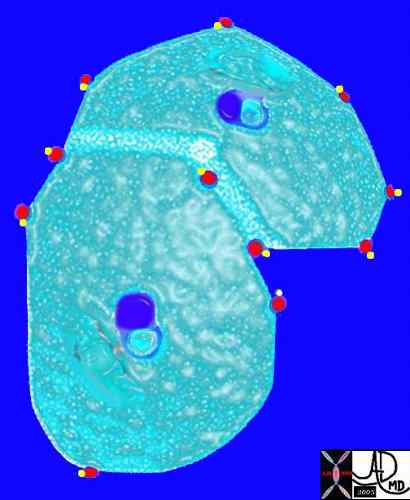
The arteries and airways pair up and travel together from the interlobular septa to the hilum. The pulmonary lobule, also called the secondary lobule is a structural unit surrounded by a membrane of connective tissue, and it is smaller than a subsegment of lung but larger than an acinus. This diagram shows two secondary lobules lying side by side. The pulmonary arteriole (royal blue) and bronchiole (pink) are shown together in the centre of the lobule (“centrilobular”), while the oxygenated pulmonary venules (red) and lymphatics (yellow) are peripheral and also form a formidable and almost inseparable pair.
42440b03
Ashley Davidoff MD
TheCommonVein.net
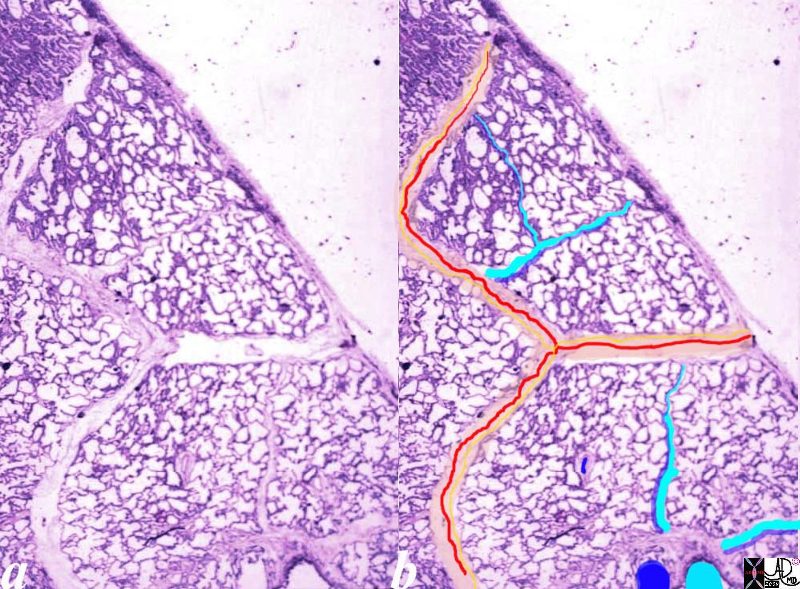
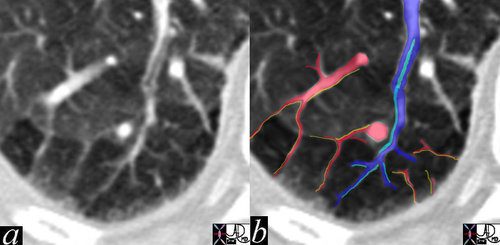
The high resolution CT shows multiple secondary lobules in the periphery of the right lung. A lobular bronchiole is overlaid in teal, while the accompanying lobular arteriole is seen in royal blue entering the lobule and then branching. The peripheral venules are identified in the interlobular septa (red) and joining to form the lobular vein.
In this remarkable CT we were able to identify a few secondary lobules at the periphery of the lung that have a rectangular shape in this instance. The branching structure that enters the lobule (blue in b), is characterised as an arteriole for two reasons. Firstly it is paired with a tubular airway seen in (a) in its most proximal portion as a lucent tubule, and subsequently interpolated in light blue in b. Secondly it branches in the centre of the lobule. It is distinct from the border forming interlobular septum which surrounds it. A second relatively large vessel colored in red receives a branch from the interlobular septum and by virtue of its size and position it has to be a pulmonary venule. We know that the lymphatic vessel accompanies the venule, and so the yellow lymphatic has been implied but not visualised. We also know that connective tissue surrounds these two structures. In this instance the matrix of the lobule that consists of the alveoli is less dense than it should be and is surrounded by normal alveoli. Lucency implies air trapping and air trapping implies small airway disease. Thus this image tells us that the criminal in this case of disorder is the small airway, We now can focus on the small airways with a pathological differential diagnosis, and from there plan the treatment.
Ashley Davidoff MD TheCommonVein.net 47152c01
Anatomy
There are usually 4 pulmonary veins.
They are the superior and inferior right pulmonary veins and the superior and inferior left pulmonary veins.
The right superior pulmonary vein drains the right upper and middle lobe. The two veins join to form the most anterior structure in the hilum.
The left superior pulmonary vein drains the left upper and lingular segments.
The inferior veins drain the lower lobes.
The veins are the shortest of the three major vessels originating in the hilum. The longest structures are the bronchi and second to them are the pulmonary arteries. This has implication in cross sectional imaging where all these structures converge. Therefore when the central areas are viewed there will be a single bronchus and artery, but usually two veins on either side. The upper veins will be anterior to the bronchus and artery and the lower veins will be posterior and inferior.
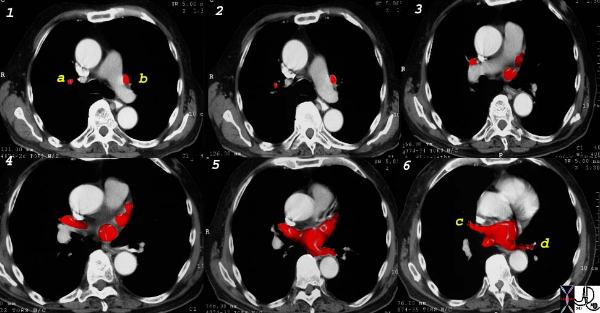
This is a collage showing the CT appearance of the pulmonary veins as they converge onto the left atrium. Note the vertical course of the right superior (a) and left superior veins (b) in image 1, where they appear as rounded to ovoid structures. In image 6, the right inferior (c) and left inferior (d) are seen as tubular structures since their course is more horizontal.
Ashley Davidoff MD TheCommonVein.net 31662b3_1
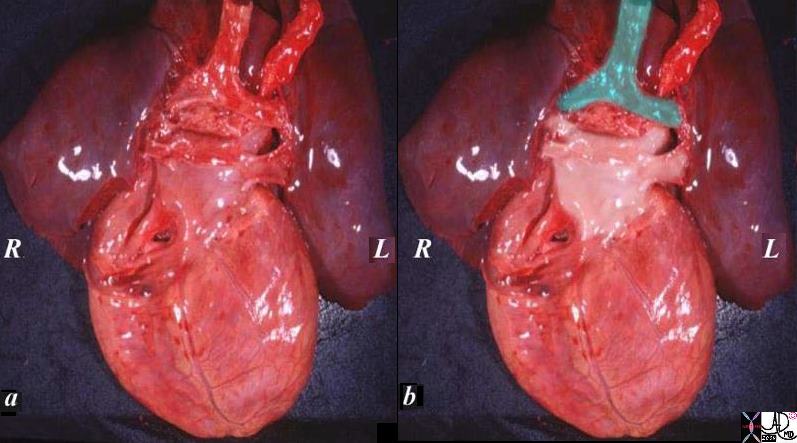
The specimen of heart and lungs is examined from posteriorly with the left atrium and 4 pulmonary veins. (overlaid in pearl white) The trachea and bronchi are intact (green). The left atrium lies just below in the angle of the carina.
Ashley Davidoff
TheCommonVein.net
08376c02.82s
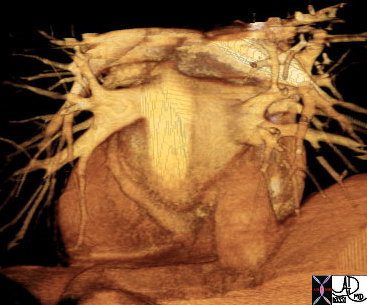
Surface rendering of the left atrium and pulmonary veins seen from the posterior aspect.
Ashley Davidoff MD TheCommonVein.net 39704b01

Normal coronal reconstruction of a CT scan of the Heart Showing the Left Atrium (LA) and Pulmonary Veins and Left Ventricle (LV) Note the relatively horizontal orientation of the lower lobe pulmonary veins.
Ashley Davidoff MD TheCommonVein.net 34763
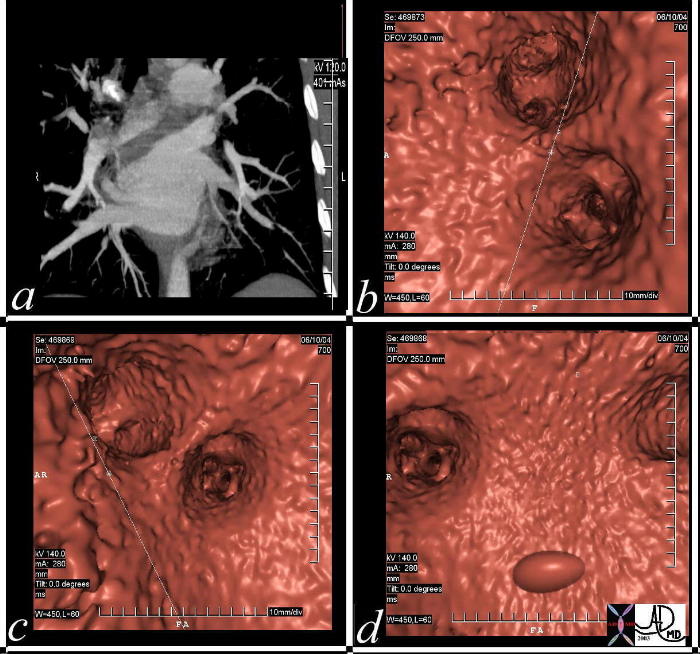
This series of MDCT demonstrates the pulmonary veins and the left atrium in coronal projection (a), and using virtual projections (b, c, d). Courtesy Ashley Davidoff MD TheCommonVein.net 37236c

Size
SPV ostia larger
|
ostia (cms) |
1cms from ostia (cms) |
|
|
RSPV |
1.7 +/-.24 cms |
1.4 +/-.21 cms |
|
RIPV |
1.59+/- .25 cms |
1.16 +/-.25 cms |
|
LSPV |
1.76 +/-.41 cms |
1.45 +/-.32 cms |
|
LIPV |
1.39 +/- .29 cms |
1.23 +/-.24 cms |
Shape
The left pulmonary veins are oval ostia oval. The right pulmonary vein ostia are circular

MIP images of a CTscan with both Venous and Arterial Phases
This compounded CT of the chest shows the pulmonary vascular circulation including the pulmonary veins draining into the left atrium. The pulmonary arteries can be seen in the background. Note the asymmetric appearance in size shape and branching patterns of the pulmonary veins
Ashley Davidoff MD TheCommonVein.net 32653
Position of the veins
In cross section, the upper veins will be anterior to the bronchus and artery and the lower veins will be posterior and inferior.
In the coronal plain, the upper lob veins lie lateral to the arteries, while in the lower lobes, the veins lie horizontal and inferior to the pulmonary arteries.
Usually right middle lobe vein drains into right superior vein in 70% directly into LA 20% and 5% intp RIPV
Lingula vein usually arises from the left superior pulmonary vein.
In 10-25% patients there is a single vein on one side. This is more common on the left

In this coronally oriented CTA the right upper lobe pulmonary vein can be seen running medial to the artery and the right lower pulmonary vein can be seen running in a more horizontal plain and the LPA origin hides behind the MPA as it courses posteriorly. Courtesy Ashley Davidoff MD TheCommonVein.net 32807b03.8s


This is a normal venous phase of a digital pulmonary angiogram showing the venules from the upper vertically oriented veins and the lower, horizontally oriented veins. Courtesy Ashley Davidoff MD. 27658
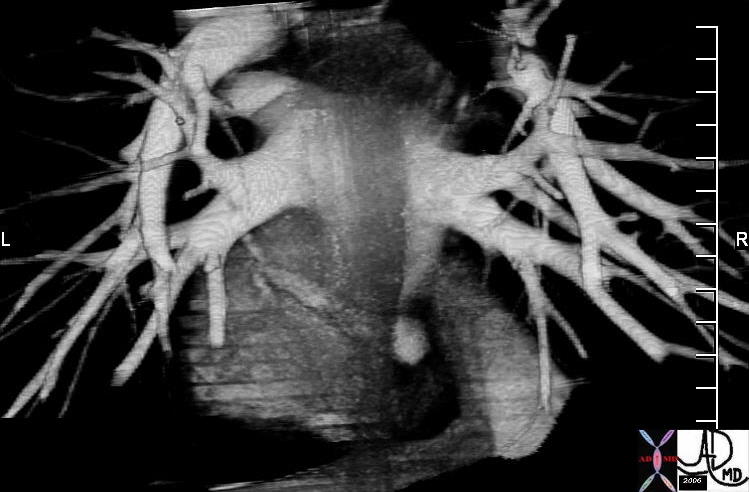

Normal 3D coronal reconstruction of a CT scan of the heart showing the left atrium (LA) and pulmonary veins and pulmonary arteries. Note the relatively horizontal orientation of the pulmonary veins compared to the lower lobe pulmonary arteries.
Ashley Davidoff MD TheCommonVein.net 34764
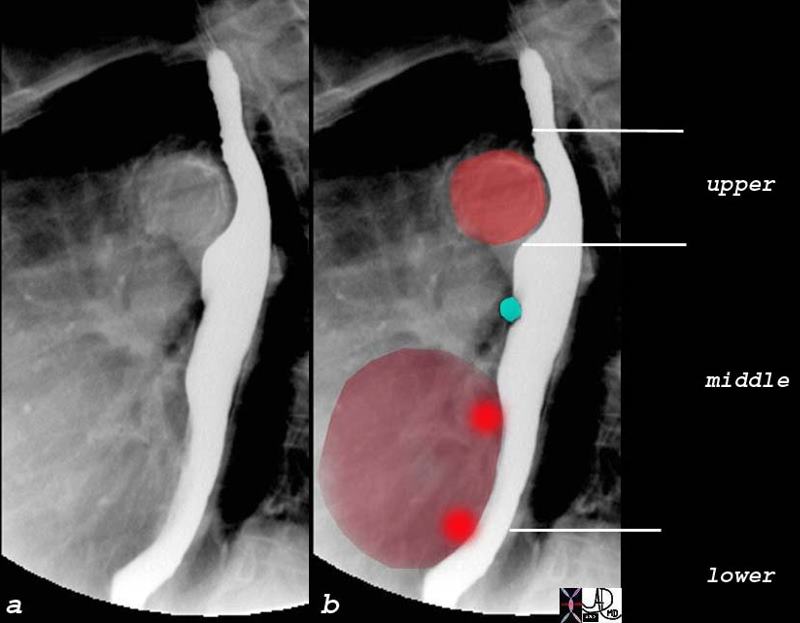

The normal indentations on the esophagus include the aortic arch and knob seen in bright red in b. The left bronchus is usually seen as a oblique line crossing the back of the esophagus, but in this case is seen as a focal indentation on the anterior wall. The left atrium is seen pulsating against the distal esophagus (maroon) usually when the left atrium is enlarged.
Courtesy Ashley Davidoff MD TheCommonvein.net 76119c02
Relations
Applied Anatomy
Diseases of the pulmonary veins are most commonly secondary to left sided heart disease where an elevated left ventricular or left atrial pressure is reflected in the pulmonary veins.


In these images. and c are normal and b and d represent thickened interlobular septa in a patient with congestive heart failure. These are the well known Kerley lines, often spoken about but rarely seen. They are identified as thin horizontal lines usually seen in the costophrenic angles, not being longer than 2 cms in length and touching the pleural surface.
Ashley Davidoff MD TheCommonVein.net
42545c01
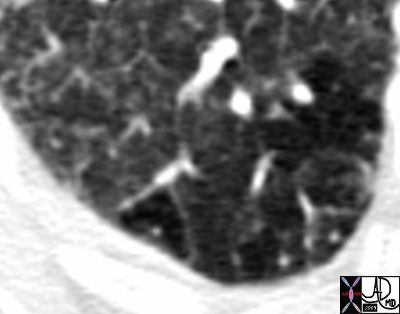

Thickened Interlobular Septa
81F hx atrial fibrillation cardiac failure heart failure CHF RA enlarged LA enlarged ground glass mosaic perfusion Kerley B lines
Ashley Davidoff MD TheCommonVein.net 44194b01
There are a series of congenital anomalies of the pulmonary veins including partial and total anomalous venous return.
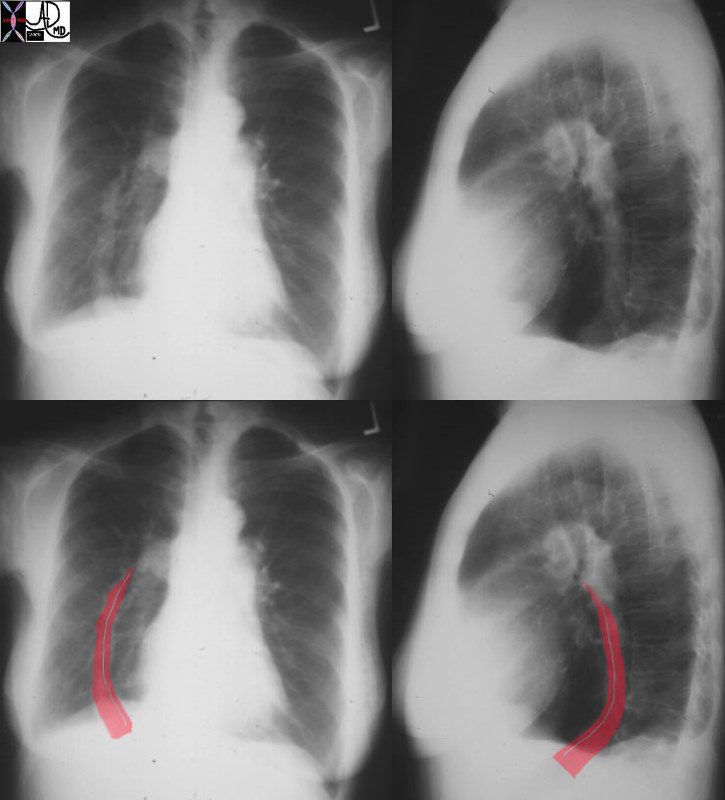

Scimitar Syndrome
This chest series are characterised by an abnormal curving vascular structure that appears to get larger as it approaches the diaphragm. In addition, the volume of the right lung is smaller than the left, and there is an odd shape to the right hilum. The findings are consistent with a diagnosis of congenital hypoplasia of the right lung associated with partial anomalous venous return to the IVC below the diaphragm. (aka congenital pulmonary veno-lobar syndrome) The curved anomalous vein is known as the scimitar sign since it has the shape of a scimitar.
Ashley Davidoff MD TheCommonVein.net 01714c03
Total anomalous venous return (TAPVR) can occur with the final destination either above the diaphragm or below. Sometimes, the TAPVR below the diaphragm connects to primitive venous origins of the hepatic circulation so that pulmonary venous return is to the sinusoids of the liver. This condition as an untreated anomaly, cannot sustain life since the pressure of the oxygenated blood in the sinusoids is close to zero, and there is therefore no driving force to allow it to traverse the sinusoids. Hence there is a functional obstruction.
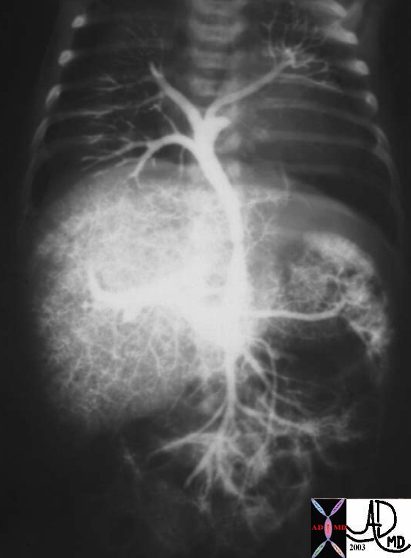

This is an angiogram of total anomalous pulmonary venous return to the portal system below the diaphragm. The pulmonary venous return has to go through a second low pressure capillary system of the liver sinusoids before it can get back to the left sided circulation and therefore there is a functional obstruction, resulting in pulmonary venous congestion, and secondary pulmonary hypertension..
Ashley Davidoff MD TheCommonVein.net 07498


Courtesy Ashley Davidoff MD TheCommonVein.net 24131
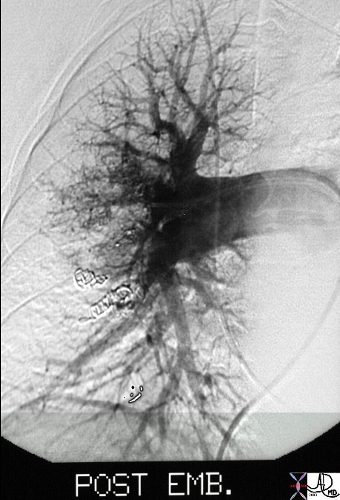

Courtesy Ashley Davidoff MD TheCommonVein.net 24137


26 year old male who presents with shortness of breath a few months following RFA ablation for atrial fibrillation. Image a is a CT scan with contrast in the axial plane, and shows the left upper lobe thrombosed and the left lower vein contrast filled
Image b (the lung windows) shows thickening of the interlobular septa and secondary lobules distended with material, probably representing blood.
Courtesy Ashley Davidoff MD Scott Tsai MD TheCommonVein.net key words ground glass changes pulmonary infarction venous infarction
75413c02
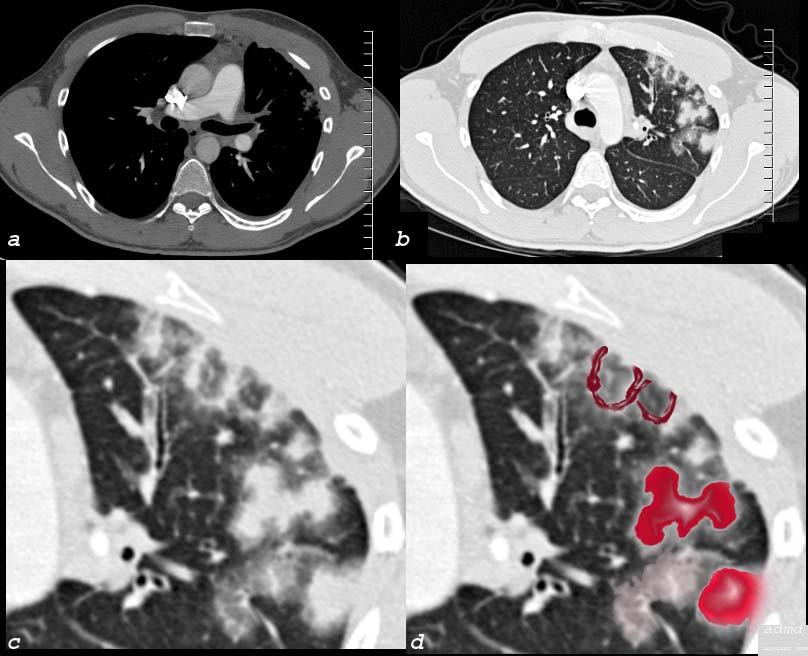

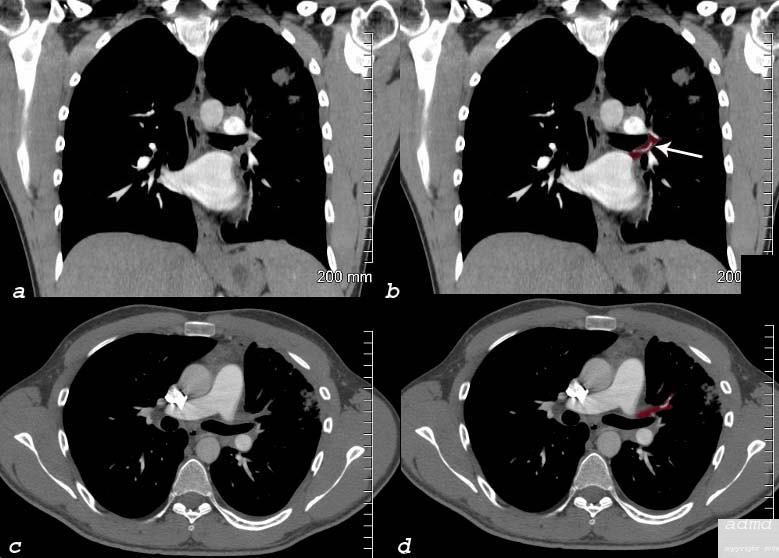

CT scan with contrast in coronal (a,b) and axial (c,d) planes in a 26 year old male who presents with SOB s/p RFA ablation for atrial fibrillation
A vein of the left upper lobe is thrombosed as noted in the images a, and c, and overlaid in maroon in , images in b (white arrow) and d, secondary to radiofrequency ablation
Ashley Davidoff MD Scott Tsai MD 75413c08
Occlusion by Squamous Cell Carcinoma
Large Central Mass with Obstruction of the Pulmonary Vein and Encasement of the Arteries – Squamous Cell Carcinoma
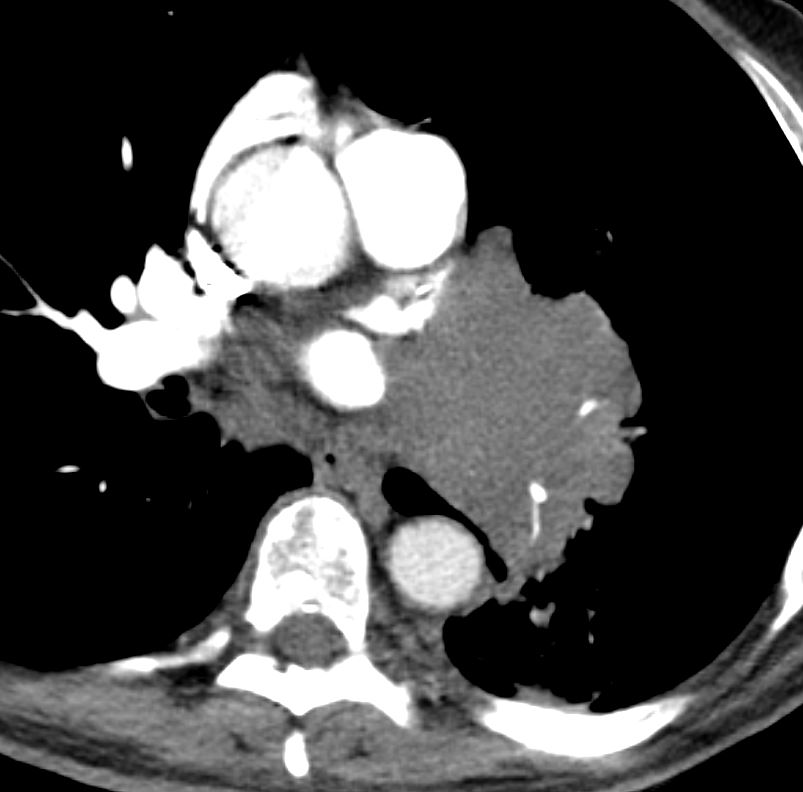

Ashley Davidoff MD TheCommonVein.net occluded-pulm-vein-005
Occluded Pulmonary Vein
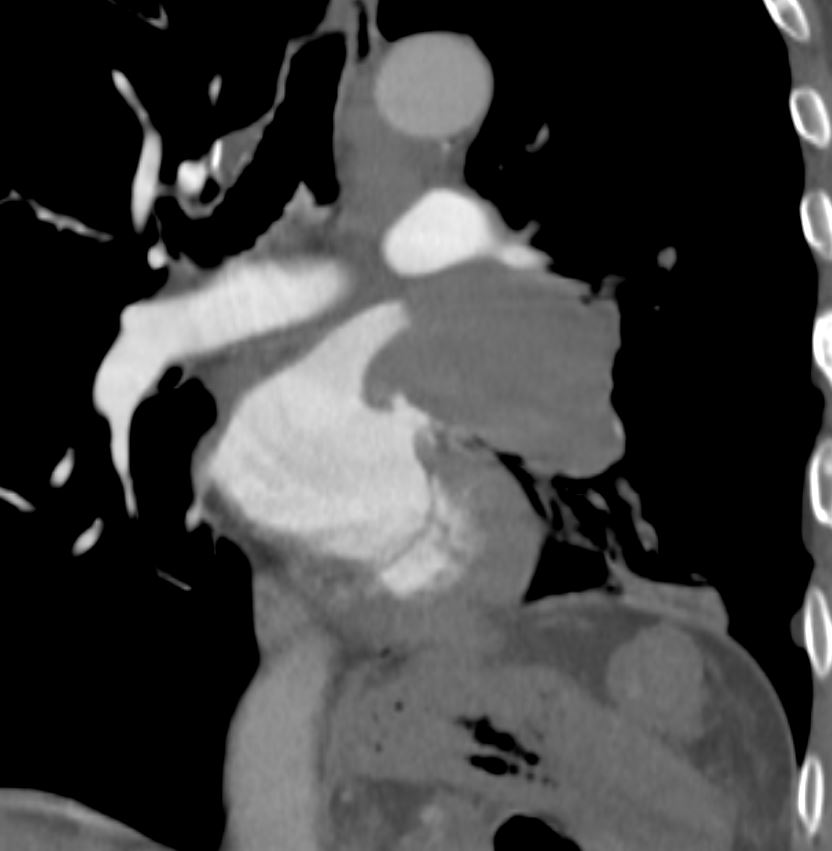

Ashley Davidoff MD TheCommonVein.net occluded-pulm-vein-001
Encased Pulmonary Artery
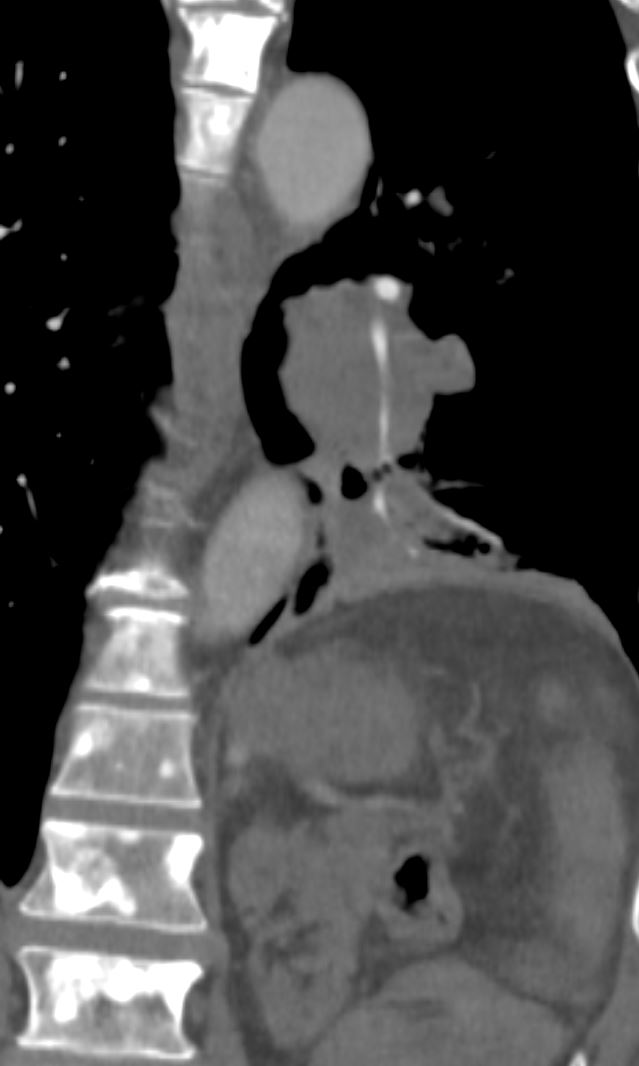

Ashley Davidoff MD TheCommonVein.net occluded-pulm-vein-001
Artistic Renderings


Normal 3D reconstruction of a CT scan of the Heart Showing the Left Atrium and Pulmonary Veins
Ashley Davidoff MD TheCommonVein.net 77612b.3kb08.8s
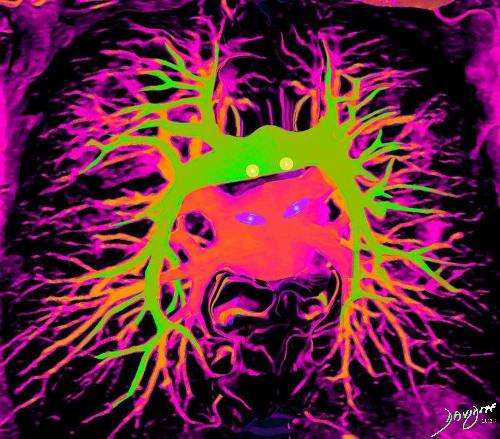

Courtesy Ashley Davidoff MD TheCommonVein.net lungs-0018


In this coronally oriented CTA the RPA can be seen traveling horizontally above the LA and the LPA origin hides behind the MPA as it courses posteriorly. Ashley Davidoff MD TheCommonVein.net 32807



In this coronally oriented CTA the RPA can be seen traveling horizontally above the LA and the LPA origin hides behind the MPA as it courses posteriorly. Courtesy Ashley Davidoff MD TheCommonVein.net 32807b03.8s


